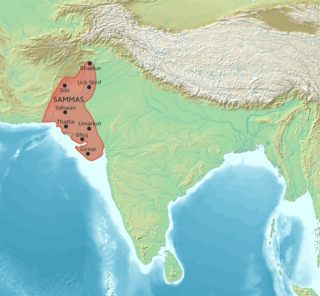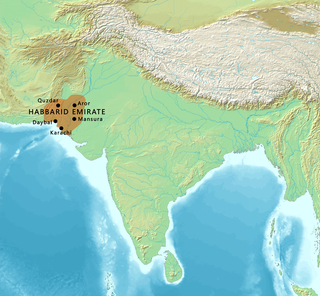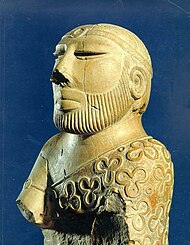
Sindh is a province of Pakistan. Located in the southeastern region of the country, Sindh is the third-largest province of Pakistan by land area and the second-largest province by population after Punjab. It is bordered by the Pakistani provinces of Balochistan to the west and north-west and Punjab to the north. It shares an International border with the Indian states of Gujarat and Rajasthan to the east; it is also bounded by the Arabian Sea to the south. Sindh's landscape consists mostly of alluvial plains flanking the Indus River, the Thar Desert of Sindh in the eastern portion of the province along the international border with India, and the Kirthar Mountains in the western portion of the province.

Sindhis are an Indo-Aryan ethnolinguistic group who speak the Sindhi language and are native to the Sindh province of Pakistan. The historical homeland of Sindhis is bordered by the southeastern part of Balochistan, the Bahawalpur region of Punjab and the Kutch region of Gujarat. Having been isolated throughout history, unlike its neighbours, Sindhi culture has preserved its own uniqueness.
The Musta‘lī are a branch of Isma'ilism named for their acceptance of al-Musta'li as the legitimate nineteenth Fatimid caliph and legitimate successor to his father, al-Mustansir Billah. In contrast, the Nizari—the other living branch of Ismailism, presently led by Aga Khan IV—believe the nineteenth caliph was al-Musta'li's elder brother, Nizar. Isma'ilism is a branch of Shia Islam.
Muslim Rajputs or Musalman Rajpoots are the descendants of Rajputs in the northern regions of the Indian subcontinent who generally are followers of Islam. Reportedly, they converted from Hinduism to Islam from the medieval period onwards, creating various dynasties and states while retaining Hindu surnames such as Chauhan. Today, Muslim Rajputs can be found mostly in present-day Northern India and Pakistan. They are further divided into different clans.
Soomro, Soomra,Sumrah or Sumra is a tribe having a local origin in Sindh. They are found in Sindh, parts of Punjab especially bordering Sindh, Balochistan province, and the Kutch district of the Indian state of Gujarat and also Rajasthan. The Soomras ruled throughout the Sindh and Multan regions.
The Samma dynasty was a medieval Sindhi dynasty which ruled the Sindh Sultanate from 1351 before being replaced by the Arghun dynasty in 1524.

Umerkot is a city in the Sindh province of Pakistan. The 3rd Mughal emperor Akbar was born at Umerkot in 1542.

Samma is a tribe and a community of Sindhi people called Sammat, that has origins in Sindh. The Samma are spread across Pakistan and North-West India. The Sandhai Muslims are Samma who converted to Islam. Offshoots of the main branch of Samma include the Jadejas, Chudasamas and their sub-branches.

The history of Sindh refers to the history of the Pakistani province of Sindh, as well as neighboring regions that periodically came under its sway.
The Balochs of Sindh,, is a community of Sindhi-speaking Baloch tribes living throughout the Sindh province of Pakistan.
Zainab (Sindhi: زينب, romanized: Zaīnab, lit. 'a fragrant tree'; Sindhi pronunciation: [ze:n'əb], born Zainab Tari binte Dodo I Soomro was the 5th Sardarni of Soomra ruled Sindh, who ruled from 1089 till 1098. She succeeded the rule of her father Dodo I, who nominated her before he retired, as his younger son, Sanghar, was still a minor. Zainab is considered to be the second woman in the Islamic world, after Arwa al-Sulayhi, to rule over a kingdom.

The Habbari were an Arab dynasty that ruled much of Greater Sindh, as a semi-independent emirate from 854 to 1024. Beginning with the rule of 'Umar bin Abdul Aziz al-Habbari in 854 CE, the region became semi-independent from the Abbasid Caliphate in 861, while continuing to nominally pledge allegiance to the Abbasid Caliph in Baghdad. The Habbari ascension marked the end of a period of direct rule of Sindh by the Umayyad and Abbasid Caliphates, which had begun in 711 CE.

Mansura, referred to as Brahmanabad in later centuries, was the historic capital of the caliphal province of Sindh, during the eighth century under the Umayyad Caliphate and then Abbasid Caliphate from the year 750 AD to 1006 AD. The city was founded as a central garrison by the Umayyad Forces in Sindh, the city transformed into a very vibrant metropolis during the Abbasid Era surpassing the wealth of Multan in the north and Debal in the south. Mansura was the first capital established by the Muslims in the Indian subcontinent after Muhammad bin Qasim seized the Brahmanabad territory. Mansura was built on the shores of the Indus River, it was surrounded by fertile farmland, Ibn Hauqal mentioned the wealthy local merchants who wore Baghdad Costume and were of Sindhi-Arab origins, houses were made of clay, baked bricks and plaster.
Soomro is a Sindhi tribe mainly based in Sindh, parts of Punjab bordering Sindh and in Balochistan, Pakistan.
The Jadgal is an Indo-Aryan ethno-linguistic group which speaks the Jadgali language. Jadgals are present in the Balochistan region of Iran and Pakistan, as well as in Oman.
The Numria,Noomria or Nuhmardi are native Sindhi Rajput tribes of Sindh and Balochistan. The Numria people are principal inhabitants of the Lasbela and Kohistan regions.
The Sindhis of Balochistan are an indigenous Sindhi population living in Balochistan, Pakistan.

The Sindh Sultanate or historically romanized as Sultanate of Sind, was a medieval Indo-Islamic sultanate established in the mid 14th century primarily based in Sindh and some parts of Gujarat and Punjab. Following the defeat of Soomra Emirate by the Sammas, three dynasties ruled over the Sindh Sultanate sequentially: the Samma dynasty (1351–1524), the Arghun dynasty (1520–1554), and the Tarkhan dynasty (1554–1593).









